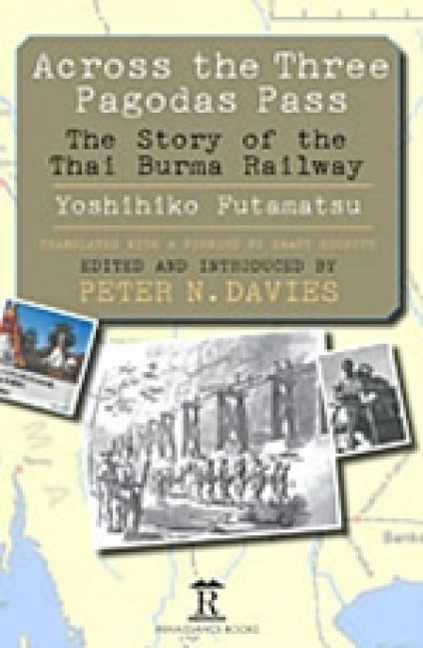Book contents
- Frontmatter
- Dedication
- Contents
- Acknowledgements
- Foreword
- Introduction
- Across the Three Pagodas Pass
- Translator’s Acknowledgements
- Preface
- Chapter 1 Departure for the Front
- Chapter 2 In Indo-China
- Chapter 3 Opening of Hostilities
- Chapter 4 The River Krian
- Chapter 5 The Malayan Campaign
- Chapter 6 The Fall of Singapore
- Chapter 7 Surrender
- Chapter 8 Shōnan: Light of the South
- Chapter 9 The Thai-Burma Railway
- Chapter 10 Preparing Construction
- Chapter 11 Banpong
- Chapter 12 Prisoners-of-War
- Chapter 13 Constructing the Railway
- Chapter 14 Thailand
- Chapter 15 The River Kwae Noi
- Chapter 16 The Mae Khlaung Bridge
- Chapter 17 Kanchanaburi
- Chapter 18 The Jungle
- Chapter 19 From Bangkok to Singapore
- Chapter 20 Rush Construction
- Chapter 21 The Base at Wanyai
- Chapter 22 The Labour Force
- Chapter 23 Survey Unit
- Chapter 24 Test Run
- Chapter 25 Bridge-Building and Shifting Earth
- Chapter 26 The Rainy Season: The Monsoon
- Chapter 27 Kinsaiyok
- Chapter 28 Diseases and Epidemics
- Chapter 29 Cattle Drive
- Chapter 30 Living in the Jungle
- Chapter 31 Soon to the Three Pagodas Pass
- Chapter 32 Towards the Setting Sun
- Chapter 33 Opening to Traffic
- Chapter 34 The Bombing
- Chapter 35 End of the War
- Chapter 36 Internment
- Chapter 37 Repatriation
- Footnote
- Postscript
- End Notes
- Glossary
- Bibliography
- Index
Chapter 1 - Departure for the Front
Published online by Cambridge University Press: 13 May 2022
- Frontmatter
- Dedication
- Contents
- Acknowledgements
- Foreword
- Introduction
- Across the Three Pagodas Pass
- Translator’s Acknowledgements
- Preface
- Chapter 1 Departure for the Front
- Chapter 2 In Indo-China
- Chapter 3 Opening of Hostilities
- Chapter 4 The River Krian
- Chapter 5 The Malayan Campaign
- Chapter 6 The Fall of Singapore
- Chapter 7 Surrender
- Chapter 8 Shōnan: Light of the South
- Chapter 9 The Thai-Burma Railway
- Chapter 10 Preparing Construction
- Chapter 11 Banpong
- Chapter 12 Prisoners-of-War
- Chapter 13 Constructing the Railway
- Chapter 14 Thailand
- Chapter 15 The River Kwae Noi
- Chapter 16 The Mae Khlaung Bridge
- Chapter 17 Kanchanaburi
- Chapter 18 The Jungle
- Chapter 19 From Bangkok to Singapore
- Chapter 20 Rush Construction
- Chapter 21 The Base at Wanyai
- Chapter 22 The Labour Force
- Chapter 23 Survey Unit
- Chapter 24 Test Run
- Chapter 25 Bridge-Building and Shifting Earth
- Chapter 26 The Rainy Season: The Monsoon
- Chapter 27 Kinsaiyok
- Chapter 28 Diseases and Epidemics
- Chapter 29 Cattle Drive
- Chapter 30 Living in the Jungle
- Chapter 31 Soon to the Three Pagodas Pass
- Chapter 32 Towards the Setting Sun
- Chapter 33 Opening to Traffic
- Chapter 34 The Bombing
- Chapter 35 End of the War
- Chapter 36 Internment
- Chapter 37 Repatriation
- Footnote
- Postscript
- End Notes
- Glossary
- Bibliography
- Index
Summary
The policy of continuing the war between China and Japan was not approved by America and, with their anti-Japanese freezing of assets as well as of oil in the southern zone, our country was increasingly under coercion. Diplomatic relations between Japan and America becoming difficult, secret preparations were pushed ahead in case by any chance it came to war. So far as we knew at the time diplomatic negotiations between Japan and America were believed to be succeeding.
Gunzoku, civilian auxiliaries of Japanese nationality, were called up nation-wide, higher management, junior management and other employees according to the district where they were born. Special Railway Bridge Unit was formed of gunzoku, as an auxiliary of a railway regiment. In the battle-zone, a railway regiment's role was to work on the enemy's railway lines and to administer the rear organization. In the event of an outbreak of war in the southern war theatre (to which we suspected we were due to join, being equipped with light summer clothing) the whole force to which we were attached had a complement of about 2,000 men. I was attached to unit HQ and in addition to me there were thirteen gunzoku senior officials in the four working companies. There were about seventy junior officials of NCO rank and altogether about 500 gunzoku were attached to the HQ and working companies. The unit was due to be sent to the Malayan front as a part of the Expeditionary Force with the Imperial Guard Division, who were nick-named ‘Miya’. Junior officials wore swords at the hip but ordinary employees had side-arms only and did not have rifles. Because we gunzoku for the most part had no experience of military training (the junior officials did not even know how to salute) we were all at sea and confused.
In the afternoon of 24 October our transport, the Hakuroku maru, slipped her moorings in the port of Ōsaka. She passed through the Straits of Shimonoseki, moving out to the open sea and that evening passed in the offing at the western tip of Kyūshū through the chain of five islands and we saw from the ship the last trace of Japanese land like the shadow of a sea-borne bird.
- Type
- Chapter
- Information
- Across the Three Pagodas PassThe Story of the Thai-Burma Railway, pp. 1 - 2Publisher: Amsterdam University PressPrint publication year: 2013



